EJBY – Eleven meteorites (H5/6, S2, 8982.4 g) found – Danekræ compensation paid – Fall on 6 February 2016 at 21:07:18-23 UTC in Ejby, Herlev, Glostrup, Rødovre, Vanløse, Sjælland, Denmark – Shattered meteorite main mass (6695.8 g) in Herlev – Finds in Ejby (58.8 g, 510.4 g, 437.7 g, 431 g, 350 g, 319 g, 38.5 g), Rødovre (58.5 g), Glostrup (64.6 g) and Vanløse (18.1 g) (UPDT: Jul 5, 2019)
An updated (2/2021) and extended version of this post
has been established on this Ejby page
(Last update of text below: 11 February 2018)
Last update: 11 February 2018 (11:00 CET)
According to a press release of the Statens Naturhistoriske Museum published on 10 February 2017 the 15 finders of Ejby meteorites are going to be paid 2 million dansk kroner (286,000 dollars) as financial compensation for the 8937.78 grams of meteorites handed over to the authorities according to the danekræ * law. For the first time all the Ejby meteorites were on display together at the Geologisk Museum during the winter holidays 2017 (7th-8th calender week). Detailed information (finder, size, weight, find location etc.) about the exhibited Ejby specimens were apparently not given. This makes it difficult to identify the individual specimens in the exhibition.
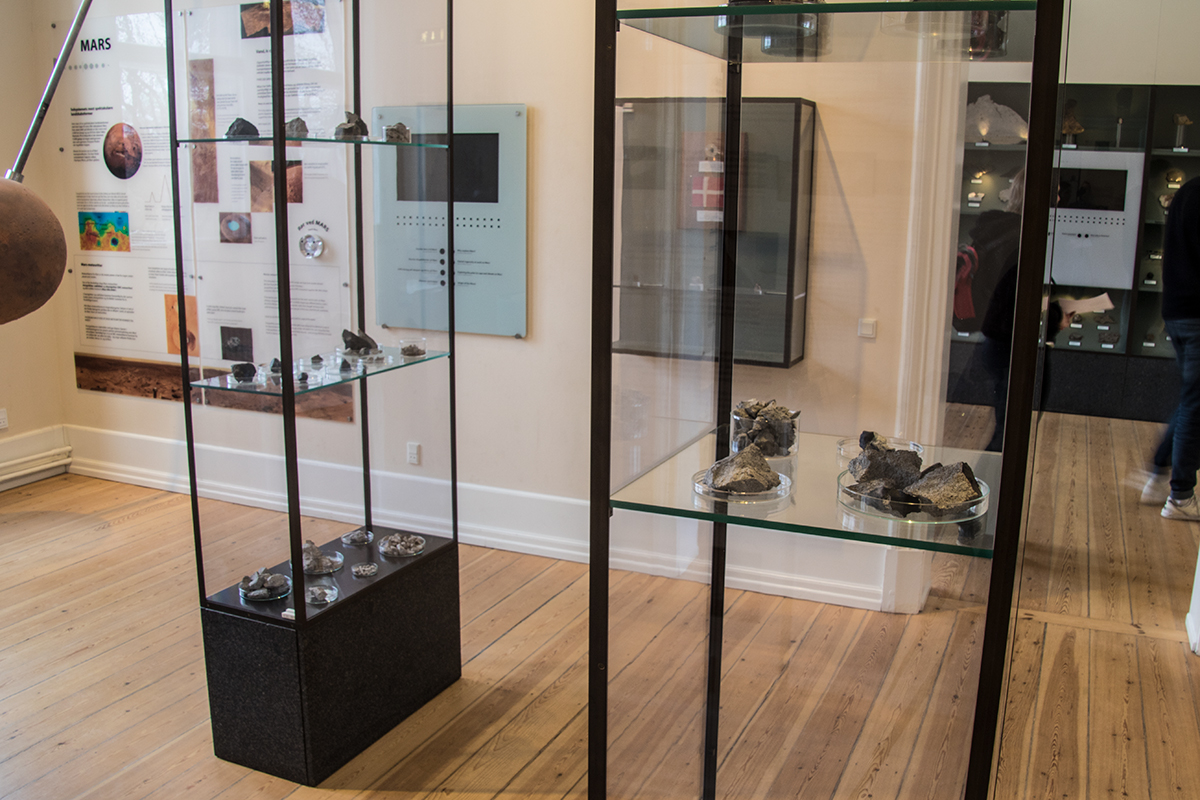
Ejby meteorite exhibition at the Geologisk Museum in February 2017. The small specimen on the right of the background row in the glass cabinet on the right seems to be the first Ejby specimen (56 g) which was found. The top shelf in the glass cabinet on the left seems to contain larger fragments of the Herlev mass and possibly Ole Henningsen’s ~522-g-specimen. The middle shelf of the left cabinet contains some intact specimens. Photo: Anders Peter Schultz, Statens Naturhistoriske Museum

The broken specimen in the front seems to be the first Ejby specimen (56 g) which was found. Image: TV2 Lorry, 10 February 2017

Ejby meteorite exhibition in February 2017 – Middle shelf – Front row (left to right): Two large broken fragments (maybe of Herlev mass) – Martin Dyrbye’s Vanløse find (18 g) – Melina’s meteorite (65 g) – Beautiful large intact individual (maybe the 300-g-specimen found in Vanløse)
Background row (left to right): Broken fragments – Broken fragments – Ejby-2 (59.5 g) Buhl/Gren – Unknown intact specimen / Image: dr.dk, 10 February 2017

Ejby meteorite exhibition in February 2017 – Beautiful large intact individual (maybe the 300-g-specimen found in Vanløse) / Image: DR.dk, 10 February 2017

Ejby meteorite exhibition in February 2017 – Melina’s meteorite (65 g) showing her crayon markings. / Image: DR.dk, 10 February 2017
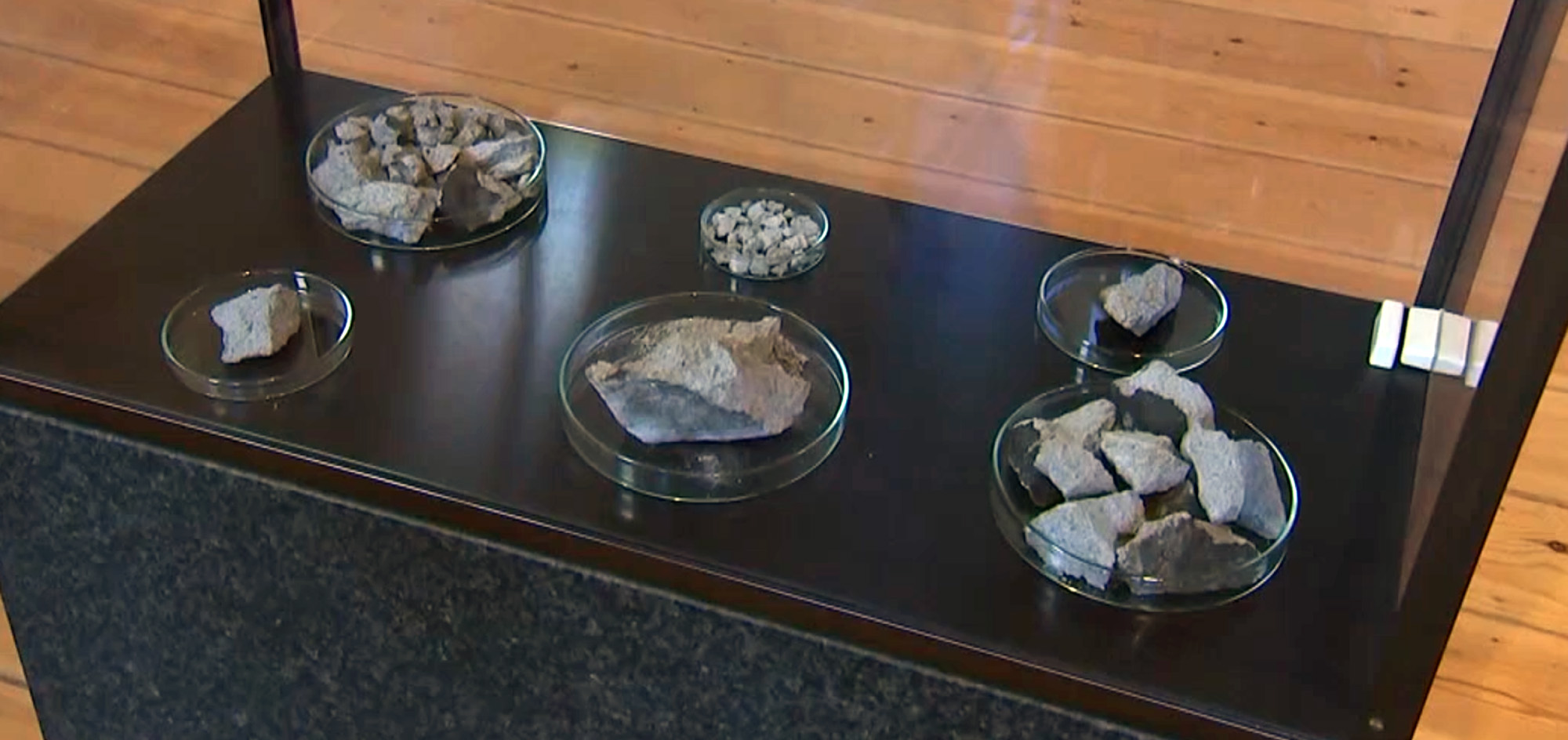
Ejby meteorite exhibition in February 2017 – Bottom shelf – Selection of broken fragments / Image: DR.dk, 10 February 2017
On 1 December 2016 the study
Atmospheric trajectory and heliocentric orbit of the Ejby meteorite fall in Denmark on February 6, 2016
by P. Spurný, J. Borovička, G. Baumgarten, H. Haack, D. Heinlein, and A.N. Sørensen was published in Planetary and Space Science.
On 27 August 2016 EJBY was officially registered in the Meteoritical Bulletin Database.
On 9 June 2016 Pavel Spurný presented a poster about the bolide (EN060316) at the Meteoroids conference at the European Space Research and Technology Centre (ESTEC) in Noordwijk, the Netherlands. The poster contains the results of the analysis of some available instrumental records, both photographic images (Kühlungsborn, Bad Doberan) and radiometric light curve data (radiometer of the Czech Růžová station). The authors provide basic parameters describing the meteoroid’s atmospheric trajectory and heliocentric orbital data.
P. Spurný, J. Borovička, G. Baumgarten and D. Heinlein
9 June 2016: Poster session 4, 09:00 – 9:30
The luminous trajectory began at a height of about 86 km a few kilometers southwest of the town Borup and terminated at a height of 18 km a few kilometers northnortheast of Taarstrup. It had a slope of about 62-63 degrees to the horizontal, was about 76 km long and had several distinct flares.
___________________________________________________
On March 4 the Natural History Museum in Copenhagen announced * that by this day nine meteorites with a total weight of about 10 kg had been found. During the week before March 4 four meteorites had been handed over to the museum. Citizens are encouraged to search for additional meteorites on the ground before the vegetation starts to grow again. An imprecise map has been published which is meant to show the most likely strewn field in which more meteorites could potentially be found.
As inofficially reported by Lars Malmgren on March 5 * the finder of the 522 gram specimen has found another specimen of about 400-500 g somewhere around this location: ~ 55°42’18.9″N 12°24’12.1″E. Additionally, the finder’s father-in-law is reported to have found a meteorite of about 400 grams somewhere around this location: 55°42’21.1″N 12°24’13.4″E. These two finds have not been officially confirmed yet.
The third Ejby meteorite (~ 522 g)
Two photos of the 522 gram mass can be seen here:
(photos: Ole Henningsen)
522 g Ejby mass
Ole Henningsen holding the 522 g Ejby mass
As inofficially reported by Lars Malmgren on March 5 * the meteorite was found in Skovlunde Naturpark, somewhere around this location : 55°42’20.3″N 12°24’07.8″E.
The second Ejby meteorite (59.5 g)
NEW FIND on February 13!
Another complete meteorite specimen with a weight of 59.5 grams was found at location 55°41’34.5”N, 12°25’59.3”E * in Ejby (Glostrup) on February 13 at 10.45 a.m. CET by renowned German amateur meteorite experts Dr. Svend Buhl (Meteorite Recon) and Andreas Gren (Meteoritehouse) after a short but systematic search in the projected strewn field based on the bolide’s luminous and dark flight trajectory which had been meticulously calculated by Dr. Karl Wimmer based on publicly available data. S. Buhl has documented the story of their recovery expedition on his website.
Respecting Danish law the meteorite was handed over to Daniel Wielandt of the Geological Museum on February 14. The Folkebladet published an article by Jesper Ernst Henriksen about the find in its February 17 print edition. Unfortunately the original article does not mention that the recovery of the meteorite was a collaborative effort of S. Buhl and A. Gren. The credit for this find must be equally attributed to A. Gren and S. Buhl. This oversight has partly been corrected in the online version * of the article.
In general it must be said that given the efforts invested in finding these freshly fallen meteorites it is decisive for the speedy recovery of any future meteorite fall in Denmark that the finders of meteorites of this fall who have willingly handed over their hard-earned finds to the authorities are compensated adequately. Meteorite recovery has always been most efficient when it was understood and undertaken as a collaborative project of ambitious amateurs and professional researchers and institutions. Only this cooperation guarantees the manpower, time and determination needed to recover a maximum amount of the scientifically important unweathered specimens of any future meteorite fall. It remains to be seen if in this particular case with its multiple meteorite finds, which make this fall a precedent in Denmark, the application of the current Danekrae law has been flexible, transparent and foresighted enough to meet the unique requirements which an event like a meteorite fall demands and which are beneficial to the advancement of meteoritics in general. UPDATE (10 Feb 2017): Unfortunately the compensation, though financially adequate, has been merely ‘financial’ and thus might not meet every finder’s expectations.
The first Vanløse meteorite (~ 300 g)
It has been reported that another meteorite has been found in Vanløse, a western district of Copenhagen. The meteorite is said to weigh about 300 grams.
The second Vanløse meteorite (18 g)
On February 8 * and February 16 it was reported * that another meteorite with a weight of 18 grams was found by Martin Dyrbye * in his garden at location 55°41’44.1″N 12°28’40.2″E * in Egholmvej 53 in Vanløse on February 8. The meteorite has been handed over to the Geological Museum and will be on display.
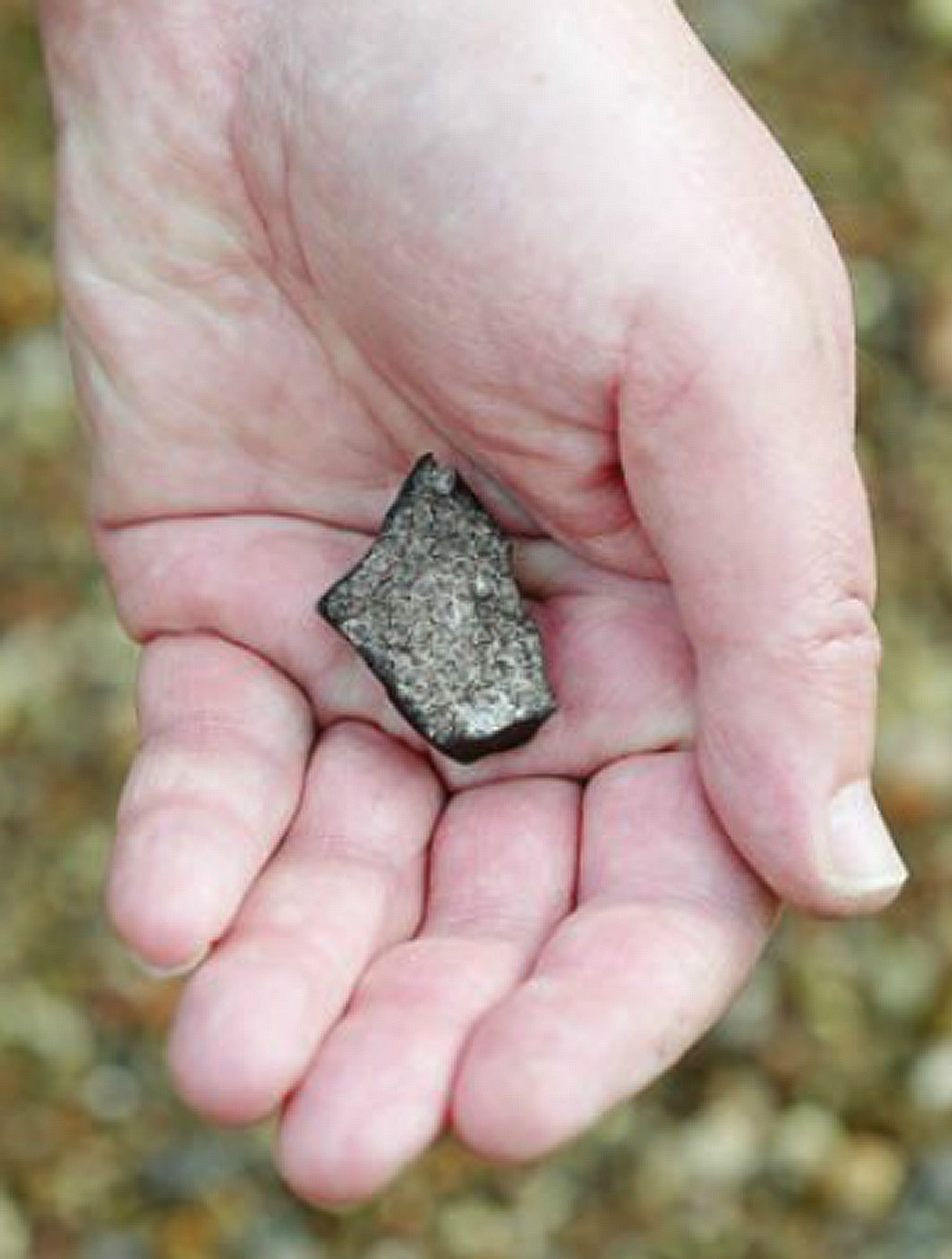
Martin Dyrbye’s meteorite (18 g) found in Egholmvej 53 in Vanløse/ Photo: Martin Sørensen / Vanløse Bladet
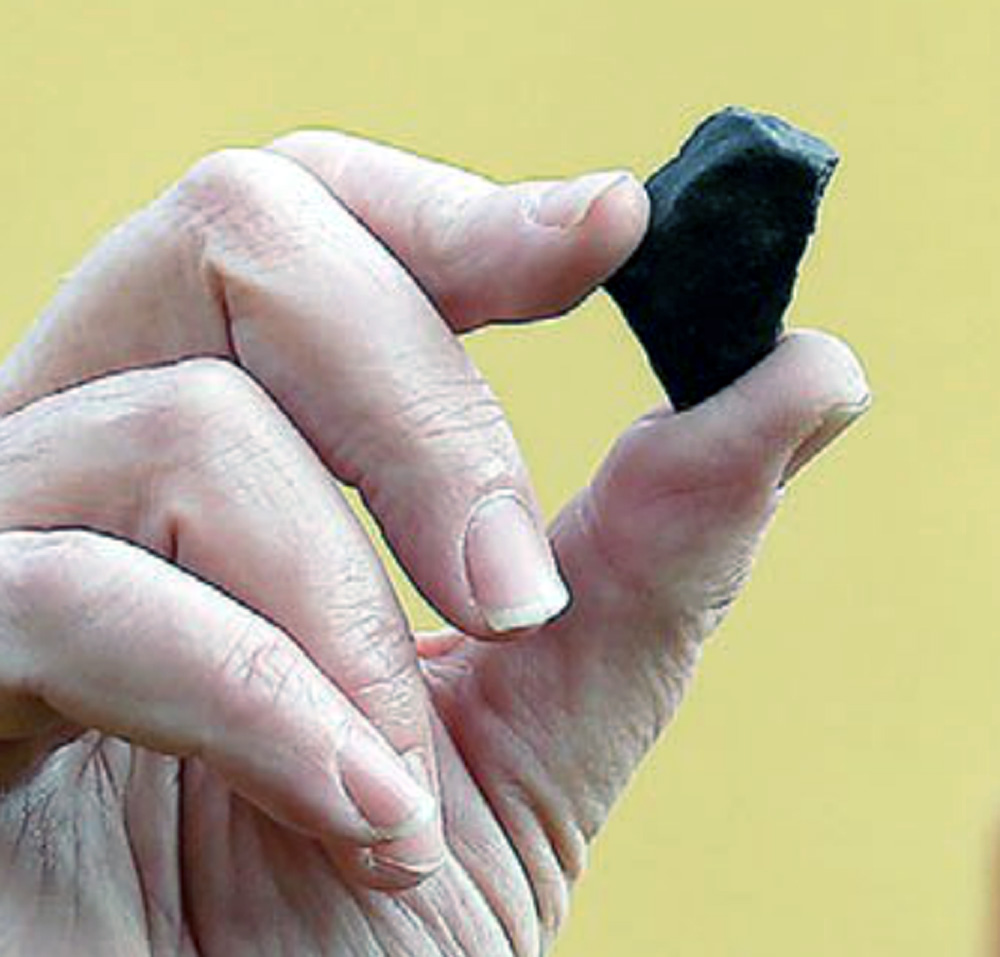
Martin Dyrbye’s meteorite (18 g) found in Egholmvej in Vanløse/ Photo: Martin Sørensen / Vanløse Bladet
Melina’s meteorite (65 g)
The 6-year-old school girl Melina Hybel Jensen found another 65 g specimen in the grass in front of her primary school (Skovvangsskolen *) in Glostrup while being on her way home from school Monday afternoon (Feb. 8). Having talked within the family about how it would be to find a meteorite on Sunday evening, her father Thomas and her mother Marie Louise told her to watch out for curious looking stones. The next day Melina found the meteorite next to her brother’s classroom. Because of its unusual black colour she showed it to her friends and later to her family which contacted Henning Haack and sent a photo. The meteorite was inspected by Haack at the Jensen’s home in the evening of February 9 and subsequently taken to the Statens Naturhistoriske Museum. The information about the find was first published on the school’s website * on February 9.

Melina’s meteorite (65 g) / The brick red zone which can be seen on the left side of the meteorite in the photo above reveals Melina’s beautiful attempt to make the black rock more attractive by coloring it with one of her red crayons. Hopefully Melina’s crayon markings will never be removed from this specimen. / Photo: glostrupskole.dk
The video below shows Henning Haack visiting Melina at home to confirm the authenticity of her meteorite (Danmarks Radio, Feb. 9, 2016, 22:04 CET):
The Herlev main mass (~6.5 kg)
As Dr Daniel Wielandt from the Geological Museum reported on February 8 additional fragments of a second meteorite, which had hit the pavement with a speed of more than 300 km/h and shattered on impact, had been found by 47-year-old master bricklayer René Rasmussen at this location (55°43’03.2″N 12°26’49.0″E) in 41-year-old Eva Diemar’s backyard in Herlev on Monday morning (Feb. 8, 2016). After the collection of the meteorite fragments by Dr Daniel Wielandt Eva Diemar herself spent up to five hours looking for additional meteorite fragments. She is reported to have found between 659 and 681 grams of fragments * * up to ~ 16 meters away from the impact pit. With the fragments she found on February 9 she is reported to have found about 730 grams in total, which have been handed over to the Geological Museum. Apparently employees of the Geological Museum returned to the impact site in order to collect more fragments which had been overlooked during their first visit. All found fragments included a total mass of ~ 6.5 kg has been published for the Herlev mass.
René Rasmussen had first assumed the discovered rock fragments were ordinary pieces of concrete * but then saw the fusion crust on them and remembered what he had seen about the Ejby meteorite on TV Sunday evening. The meteorite fragments (1 2 3) he found have been dried and are curated at the Geological Museum in Copenhagen. One of the largest fragments * of the Herlev mass with a weight of 635 grams could be seen at the Geological Museum in Copenhagen * between February 15 and 28, 2016 (see video below).

A partly crusted 635 gram fragment in situ. It’s one of the largest, if not the largest fragment of the second meteorite found at a private parking area in Herlev on Feb. 8 / Photo: TV2
The fragment (635 g) of the Herlev main mass (see above) in the Geologisk Museum in Copenhagen. (Video: Steen Norvig Thomsen)

Exact impact site of the second meteorite found in Herlev. The larger meteorite fragments have been removed with only crumbs remaining. / Photo: TV2

Impact location of the second meteorite found at the private parking area in Herlev on Feb 2 / Photo: TV2
Fragments of one of the found metorites. Most likely from the Herlev mass / Photo: Benjamin Agerriis
The first Ejby meteorite (56 g)
An elderly woman from the western part of Ejby (Glostrup) who had gone out to smoke a cigarette found a fragment of a ‘strange looking stone’ two meters from the front door on a tiled path in front of her house and presented it to her son and daughter-in-law who decided to send a photo of the specimen to Dr Henning Haack from the Statens Naturhistoriske Museum in Copenhagen. On visual inspection Haack confirmed that it was in fact a fresh meteorite, an ordinary chondrite. When visiting the finder in the evening of February 7 Dr Haack and his son found the two smaller fragments of the meteorite which had been fragmented on impact. The meteorite has been sent to Italy for analysis to have confirmation that the presented meteorite is in fact a freshly fallen meteorite of the bolide on February 6, 2016. The terrestrial age will probably be determined by analysing short-lived cosmogenic radioisotopes (e.g. 46Sc, 57Co, and 54Mn). The analysis will probably be done by Dr Matthias Laubenstein at the Laboratori Nazionali del Gran Sasso (LNGS) at the Istituto Nazionale di Fisica Nucleare. These measurements are usually essential to have found meteorites confirmed as fresh falls. Furthermore the measurements of other cosmogenic radioisotopes will enable the determination of the cosmic ray exposure age as well as the preatmospheric size of the meteoroid. The three fragments of the Ejby meteorite were on public display during an exceptional open hour for two hours (16:00-18:00 CET) at the Geologisk Museum in Copenhagen on February 8.

Dr Henning Haack presenting the fragments of the Ejby meteorite to the media on 7 February 2016 (image: dr.dk)

Dr Henning Haack presenting the three fragments of the Ejby meteorite to the media on 7 February 2016 (image: tv2.dk)
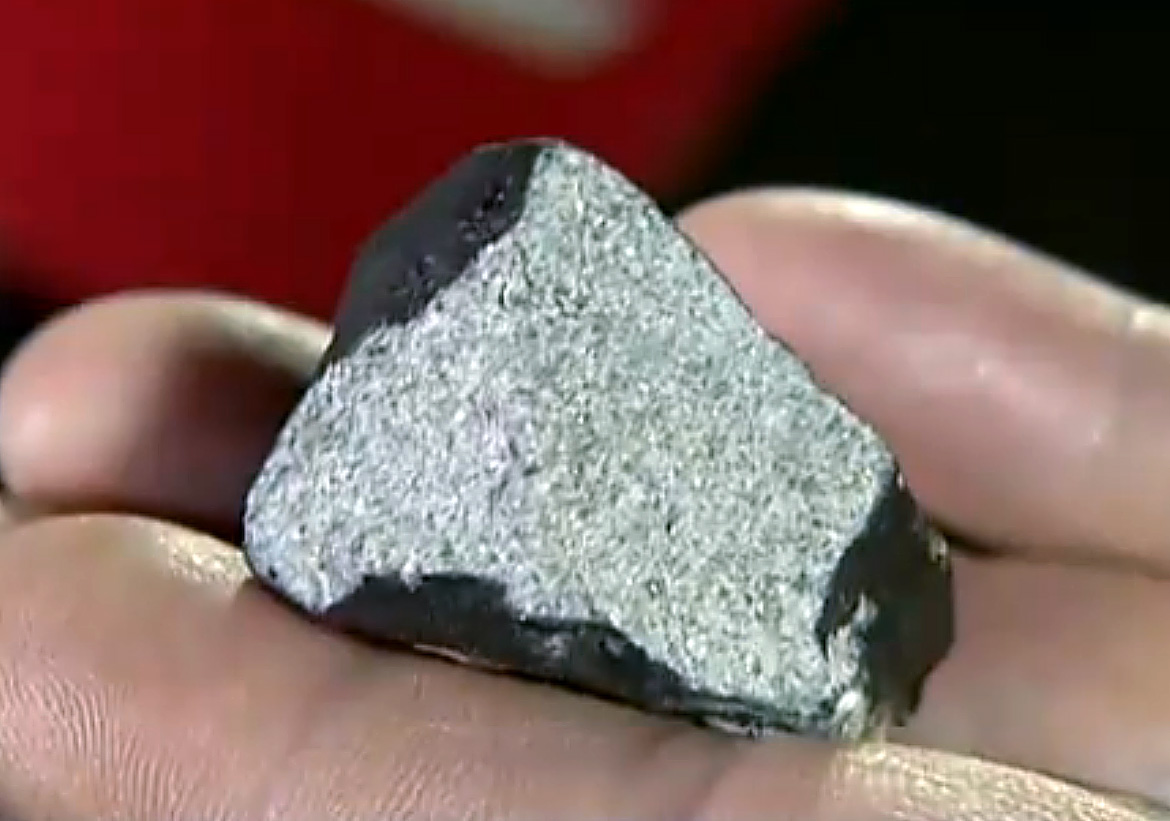
Dr Henning Haack presenting the largest fragment of the Ejby meteorite to the media on 7 February 2016 (image: tv2.dk)
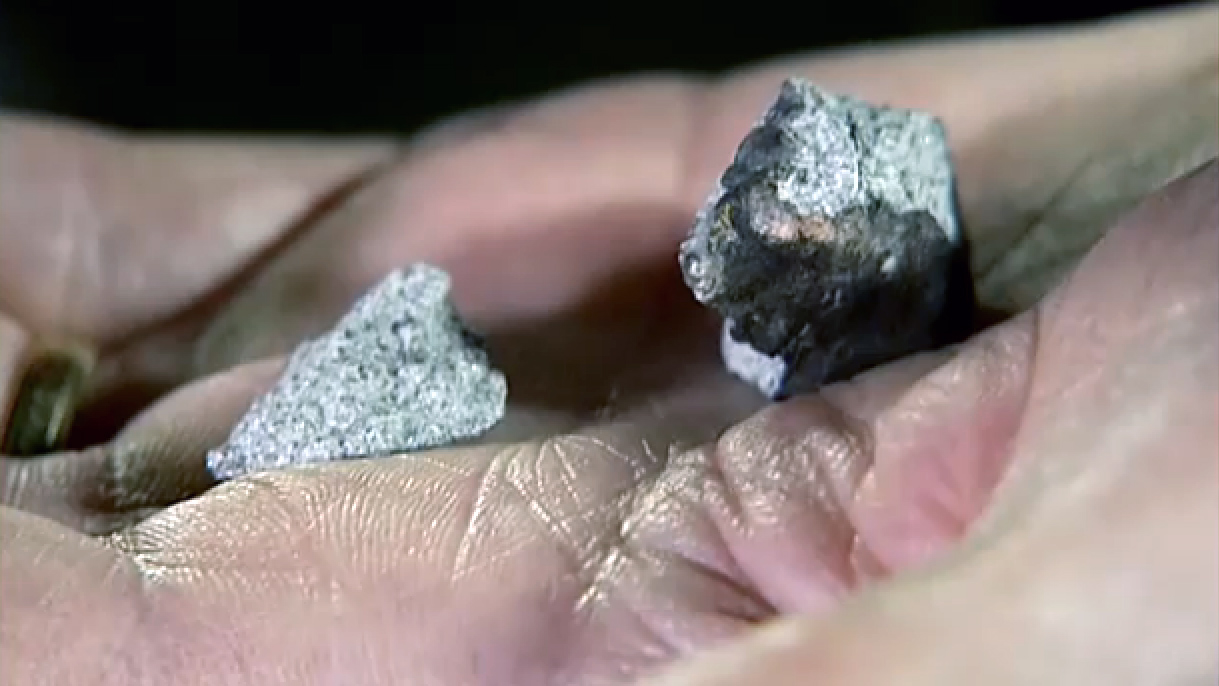
Dr Henning Haack presenting the two smaller fragments of the Ejby meteorite to the media on 7 February 2016 (image: tv2.dk)

The Ejby meteorite fragments at the Geologisk Museum / Photo: Anders Peter Schultz, Statens Naturhistoriske Museum
Radio report with interview (from 1:32 min.) with Dr H. Haack (Nyheder, Radio24syv, 8 pm , 7 February, 2016)
Danekræ
Because of the Danekræ law, introduced in 1989, the anonymous woman, René Rasmussen, E. Diemar, M. Jensen, M. Dyrbye, S. Buhl, A. Gren and all the other finders of meteorites will receive either an adequate finder’s fee or another form of compensation from the Natural History Museum for providing the meteorites to the Danish state. It remains to be seen if for this specific meteorite fall a flexible way of compensation has been found, i.e. one which measures up to the different expectations of everybody involved in the recovery of meteorites and at the same time guarantees a successful cooperation for any future meteorite fall in Denmark.
Reporting a meteorite find
updated: February 24
Ventetid for behandling af meteorit-henvendelser
Mange henvendelser
Statens Naturhistoriske Museum * har fået flere hundrede henvendelser fra borgere vedr. mulige fund af meteoritter i forbindelse med den meteor, der faldt i området omkring Herlev og Ejby den 6. februar 2016. Museet er meget taknemmelig for de mange henvendelser, men omfanget af henvendelser gør, at der kan gå op til en måned, inden der kan forventes svar.
Hvis du mener at have fundet en meteorit, må du meget gerne tage et par billeder af den og sende billederne i en mail til:
Henning Haack
Lektor
Statens Naturhistoriske Museum
Københavns Universitet
Mobil: +45 24 80 46 29
Mail: hh@snm.ku.dk
Martin Bizzarro
Professor
The Natural History Museum
University of Copenhagen
Mail: bizzarro@snm.ku.dk
Husk at skrive et telefonnummer i mailen, så vi kan kontakte dig.
Inofficially reported or unconfirmed meteorite finds
As reported by Lars Zielke on behalf of Frank on February 25 a meteorite weighing 522 grams, which is said to have been found in a small crater in a lawn next to a paved path (possibly in Ejby) on February 9, was presented in the Geological Museum.
Apparently, two employees of the Statens Naturhistoriske Museum Copenhagen have found 15 smaller and two bigger meteorites during their search efforts, as announced on twitter on February 11. * More information have not been published yet. It’s possible that the meteorites referred to above are fragments of the Herlev mass that were initially overlooked during the first collection of fragments of the Herlev mass and found later.
There’s information that another small meteorite (8 g) has been found just south of the find location of ‘Melina’s meteorite’. No further details have been published yet.
Another meteorite specimen is inofficially reported to have been found somewhere around this location * (55°42’59.3″N 12°26’15.7″E) in Herlev. No further details about this find have been published yet.
There is another inofficial claim by a Glostrup citizen that a specimen weighing about 30 grams has been found by a geologist in the eastern part of Glostrup cemetary (~ 55°40’00.7″N 12°23’43.2″E) *.
It’s more likely that other meteorite specimens or fragments have been found by other known or unknown meteorite hunters which have not officially been reported to the Naturhistoriske Museum.
The KPL sound recordings
Kristian Pontoppidan Larsen * claims to have recorded the detonation boom of the bolide in this audio recording MP3 recorded at about 21:08:23 UTC (8:23 running time) at a distance of about 15 km from Ejby and Herlev. The recorded sounds could be caused by the traffic on the road’s surface.
Frank W. Rasmussen though has recently analysed Larsen’s claim and comes to the conclusion that the noticeable sounds in the KPL recording could actually be the sonic booms of the different Ejby meteoroid’s fragmentation events. Find Rasmussen’s full report here. Feel free to send your comments on his report to continue scientific discourse on this potentially relevant and still rather unexplored aspect of the Ejby meteorite fall. Relevant comments will be published below Rasmussen’s report.
The bolide

Bolide captured by the Kühlungsborn camera (54°07’00.6″N 11°46’19.2″E / 91m a.s.l.) of the Leibniz-Institute of Atmospheric Physics e.V. (IAP). The Kühlungsborn photo was taken 183.1 km (113.8 miles) from the fall location of the large mass in Herlev. / Photo: Dr. Gerd Baumgarten
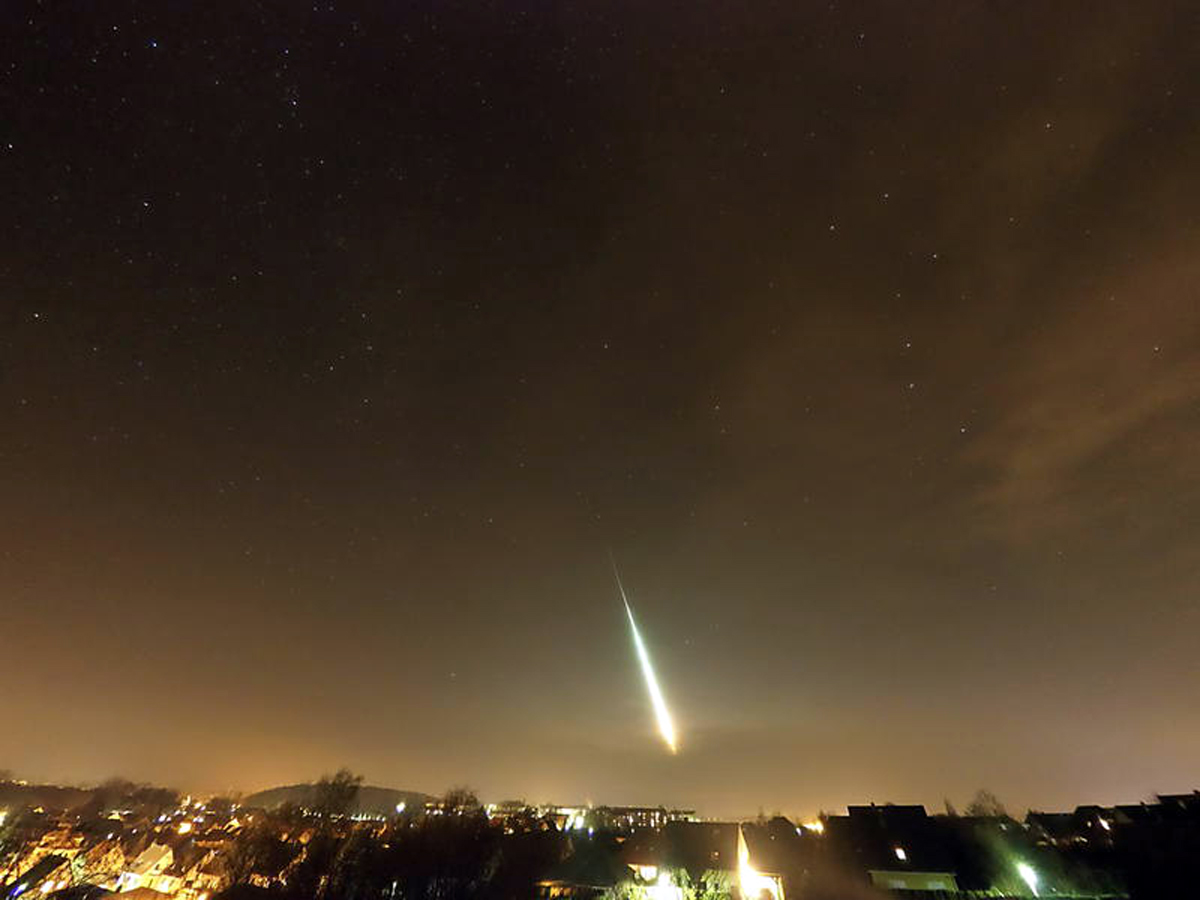
Bolide captured (excerpt) by Dr. Baumgarten’s Allsky camera in Bad Doberan (54°05’47.1″N, 11°55’19.1″E). The photo was taken 183.36 km (113.93 miles) from the fall location of the large mass in Herlev. / Photo: Dr. Gerd Baumgarten
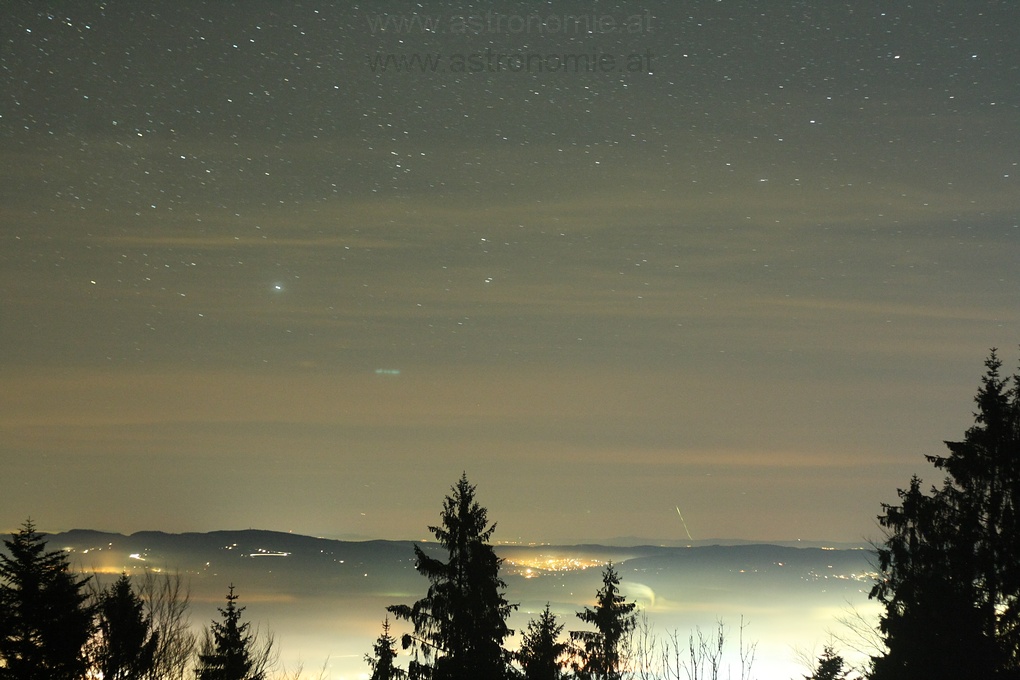
The bolide has been captured in this photo by Erwin Filimontaken at the observatory Gahberg (47°54’48″N, 13°36’33″E/ 860m a.s.l.) in Austria, i.e. about 871.5 km from the impact location of the Herlev mass / Photo: Erwin Filimon

Close-up of the photo above by Erwin Filimon at the observatory Gahberg (47°54’48″N, 13°36’33″E/ 860m a.s.l.) in Austria, i.e 871.5 km (541.5 miles) from the impact location of the Herlev mass / Photo: Erwin Filimon
This video recording (dr.dk) of a surveillance camera in Ho in Vestjylland shows a part of the bolide’s trajectory
The bolide seen from Lindenberg Observatory, Germany.
(video: André Knöfel)
Surveillance camera recordings from Gentofte
WEB LINKS
VIDEO LINK (TV2 / 7 Feb.)
VIDEO LINK (elektrabladet / 7 Feb.)
LINK (dr.dk / 7 Feb.)
LINK (dr.dk / 7 Feb.)
LINK (tv2 / 8 Feb.)
LINK (Statens Naturhistoriske Museum, Feb.8)
LINK (extrabladet, Feb.8)
LINK (tv2 / 8 Feb.)
LINK (tv2lorry / 8 Feb. 2016)
LINK (tv2 / 8 Feb.)
Ostsee-Zeitung (Feb. 8)
ekstrabladet (9 Feb.)
Glostrup Skole, Feb. 9
TV2 (Feb.9)
dr.dk (Feb. 9)
dr.dk (Feb. 9)
Vanløse Bladet (Feb. 16)
Folkebladet (Feb. 17)
meteorite-recon
Statens Naturhistoriske Museum press release (10 February 2017)
TV2 Lorry (10 February 2017)
dr.dk (10 February 2017)
Comment
by Frank W. Rasmussen
19 September 2016, 21:32
“Dear karmaka.
The purpose of this “reply” is to close the speculations about the mass of the “Herlev main mass” potentially being some 6,5 kg + 700-800 grams!
SUMMARY: THE TOTAL MASS IS 6,5 KG – ALL INCLUDED.
Argumentation:
1. In the official report on metbull (1), H. Haack reports the weight of the Herlev main mass meteorite (which shattered into hundreds of fragments) as 6,5 kg!
2. In 2 Karmaka reports (2,3) it is claimed that Dr. Daniel Wielandt (DW) on the 8. Feb reported the mass of the Herlev main mass meteorite as 6,5 kg. However no reference is provided! Most likely because this is simply a misunderstanding! [ karmaka: Yes, it was a ‘misunderstanding’ or rather a mistake while composing the texts you mentioned (2,3). They have been corrected accordingly. Thank you for your comment!]
3. In fact, many danish news media cites Ritzau (News agency) for the information, that DW estimated the mass as 0,5 kg (4, 5, 6) on the 8. Feb. In an interview to TV2. (Yes 0,5 kg!)
4. TV2 television were on location and recorded when DW (in black leather jacket) arrived at the impact site. A video is available (7). He talks about the shattered meteorite and info on mass are probaly conservative guesstimates by eyeballing (most likely no scale used, since television was on scene when DW arrived).
It should also be remembered that the fragments are spread over a rather big area, many fragments probably not visible from DW’s perspective.
5. First report of a total mass of 6,5 kg for the Herlev main mass, that I can find is an inofficial report from Lars Malmgren on the 15. February at 23.54 danish local time (8).
At this point in time (7 days after the discovery) all fragtments of the Herlev main mass are likely to be in the hands of the geological museum. Including the 700-800 grams of fragments collected by Eva Diemar on the 8. February.
Refs:
)1 : http://www.lpi.usra.edu/meteor/metbull.php?code=63682
)2 : http://karmaka.de/?p=7261
)3 : http://karmaka.de/?page_id=7682
)4 : http://www.tv2lorry.dk/artikel/nye-meteoritfragmenter-fundet-i-herlev
)5 : http://jyllands-posten.dk/indland/ECE8427454/nye-stykker-meteorit-er-fundet-paa-pplads-i-herlev/
)6 : http://www.b.dk/nationalt/nye-stykker-meteorit-er-fundet-paa-p-plads-i-herlev
)7 : http://nyheder.tv2.dk/2016-02-08-her-er-meteoritkrateret-i-herlev-der-har-vaeret-knald-paa
)8 : http://www.astro-forum.dk/forum_posts.asp?TID=14910&PN=8
BR Frank W. Rasmussen”

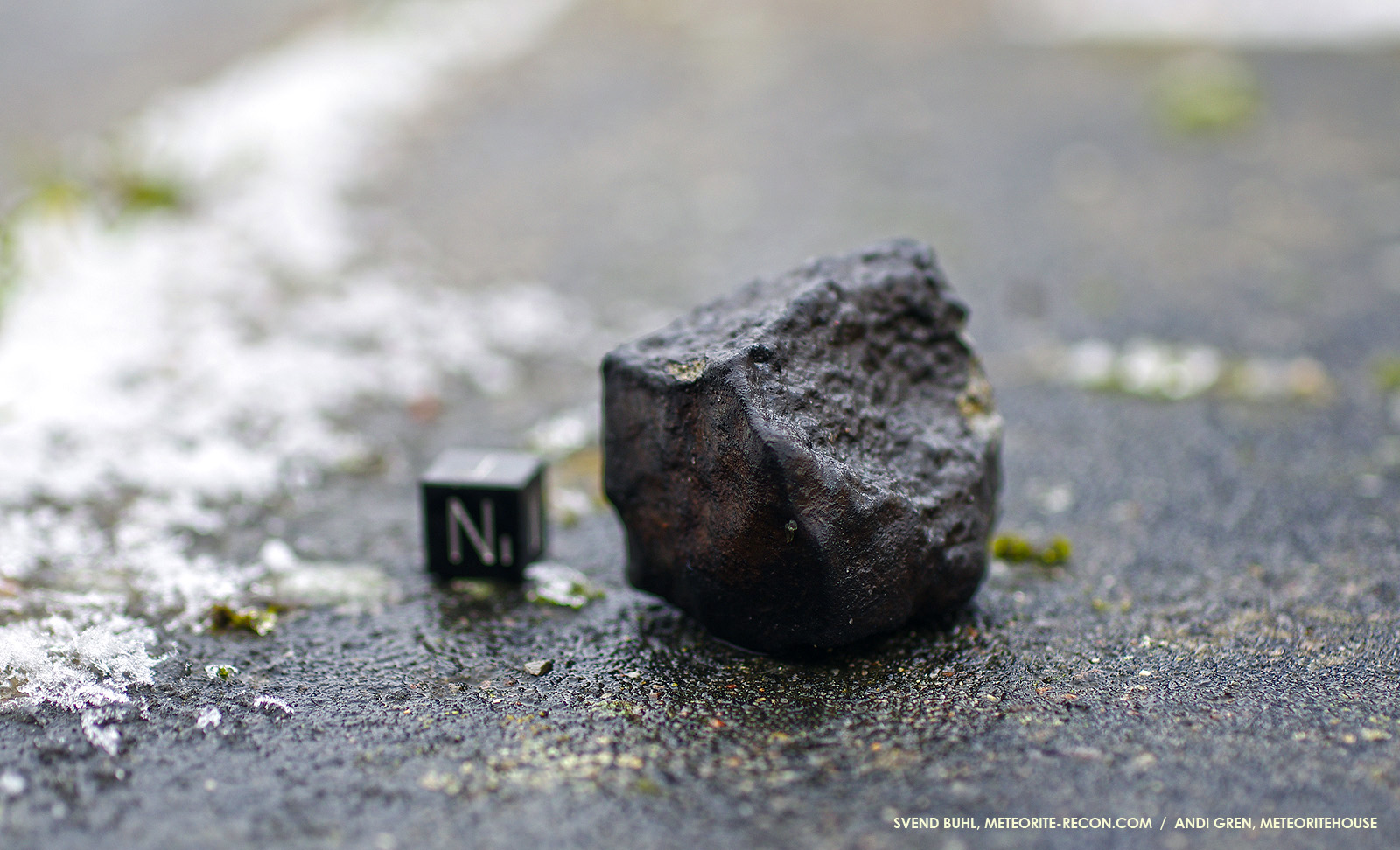
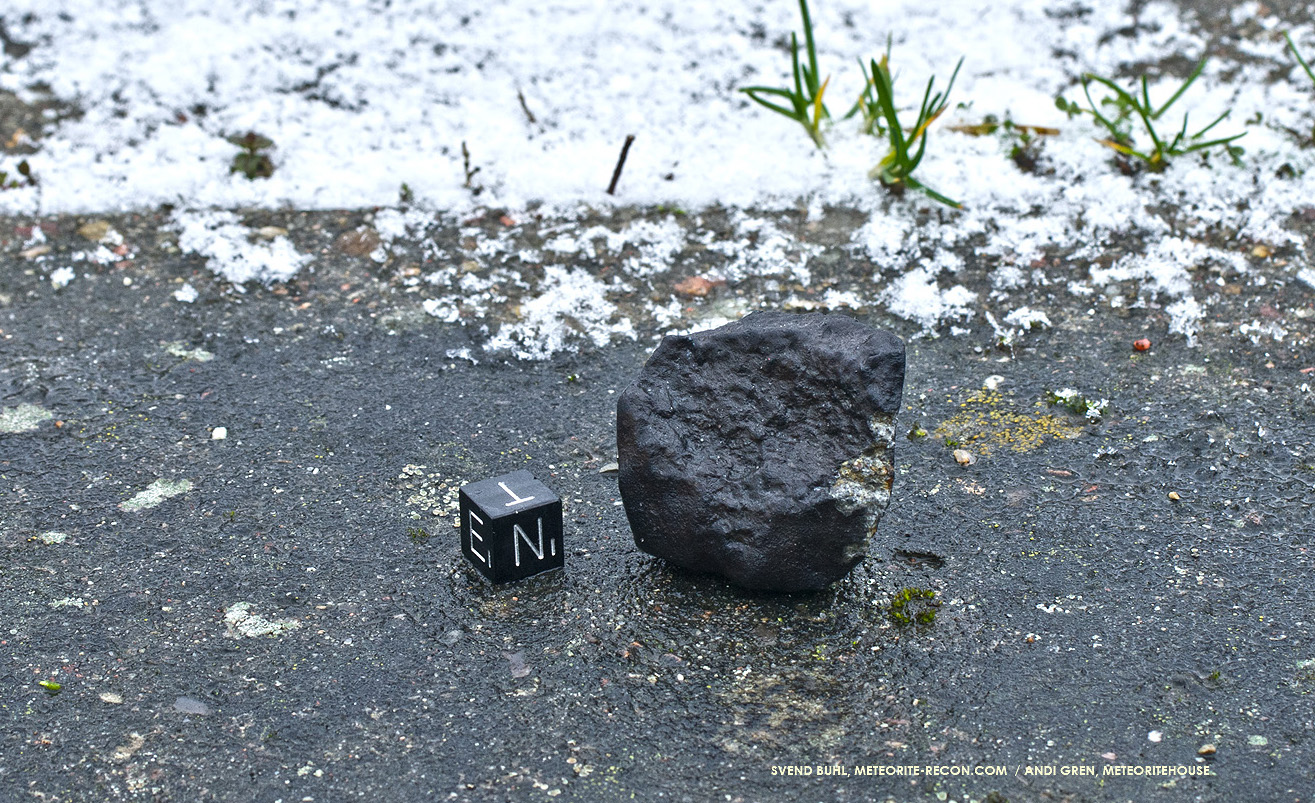


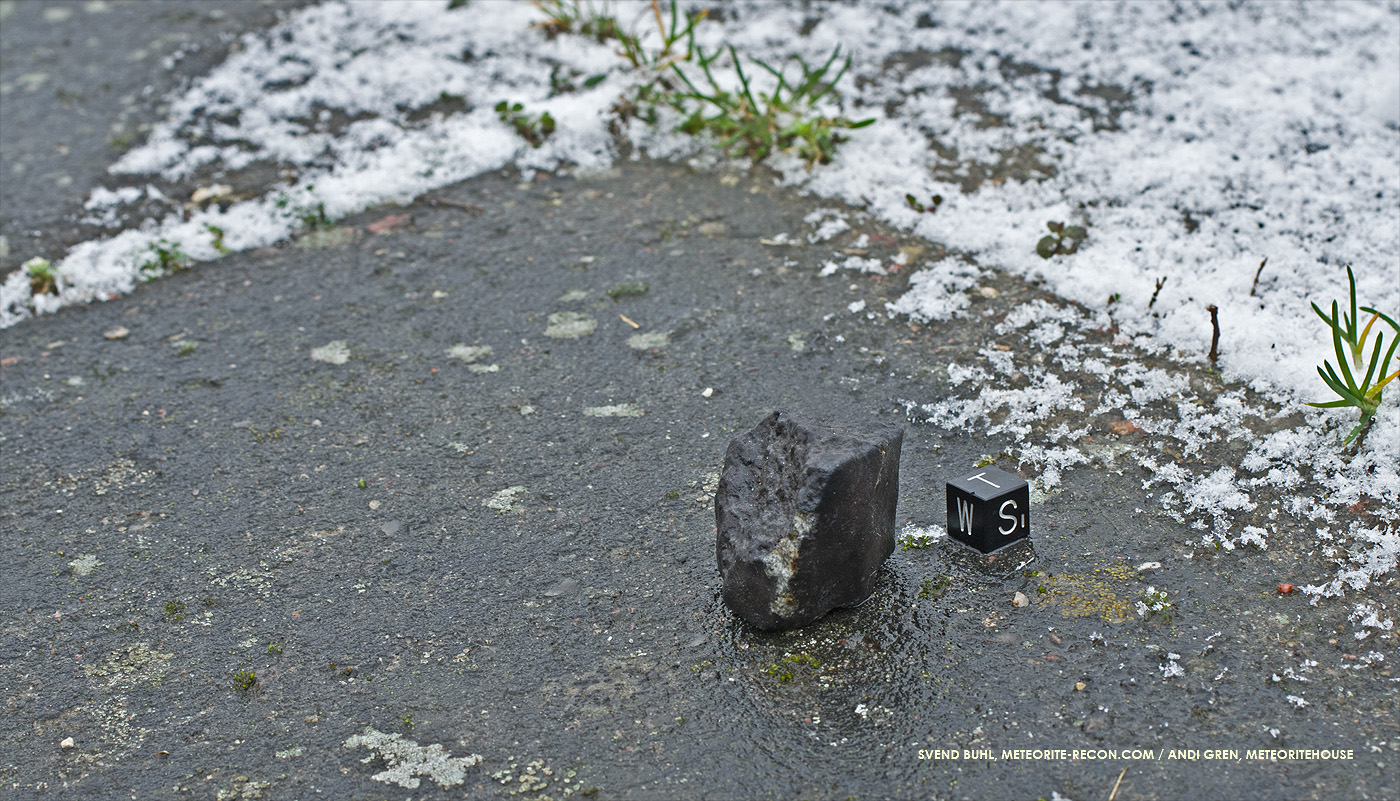



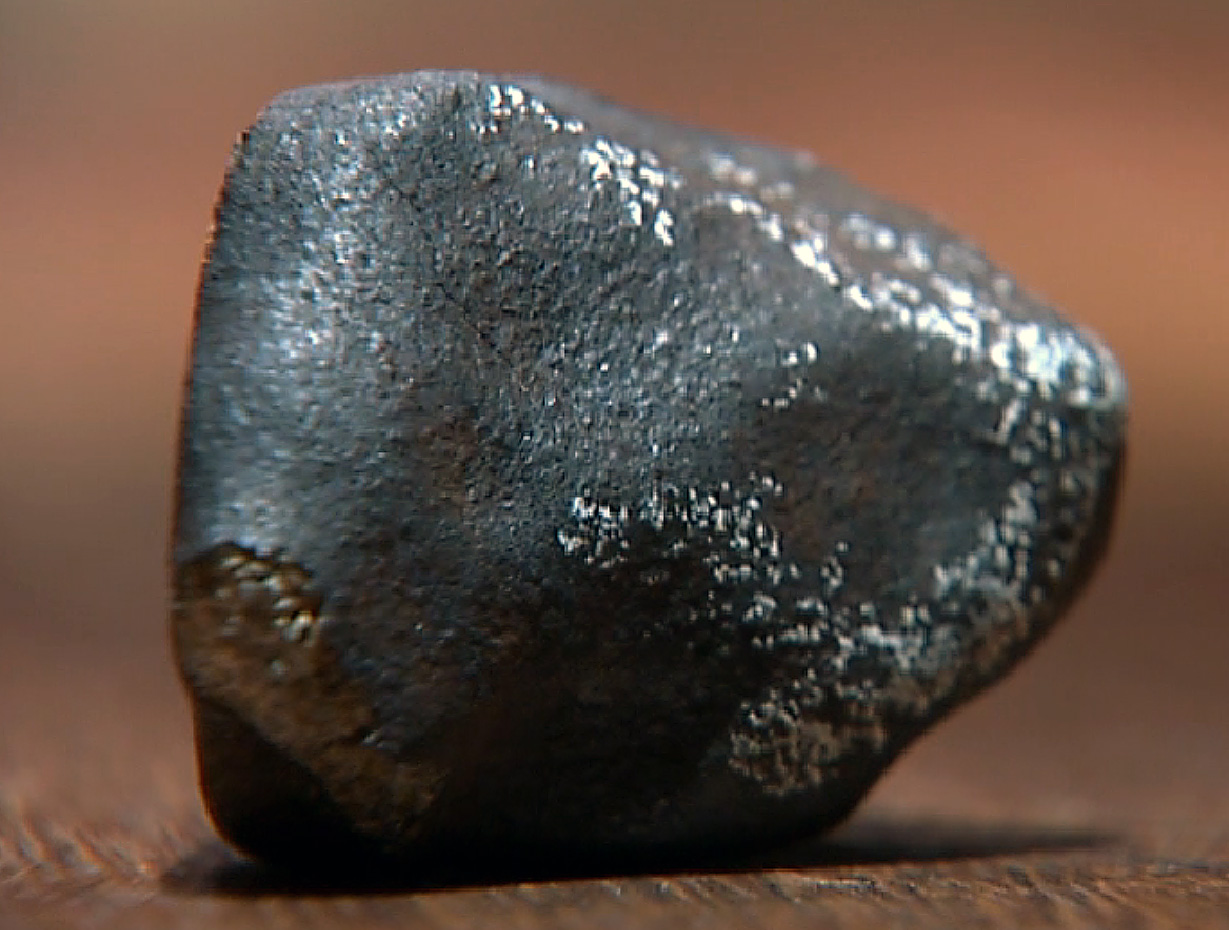

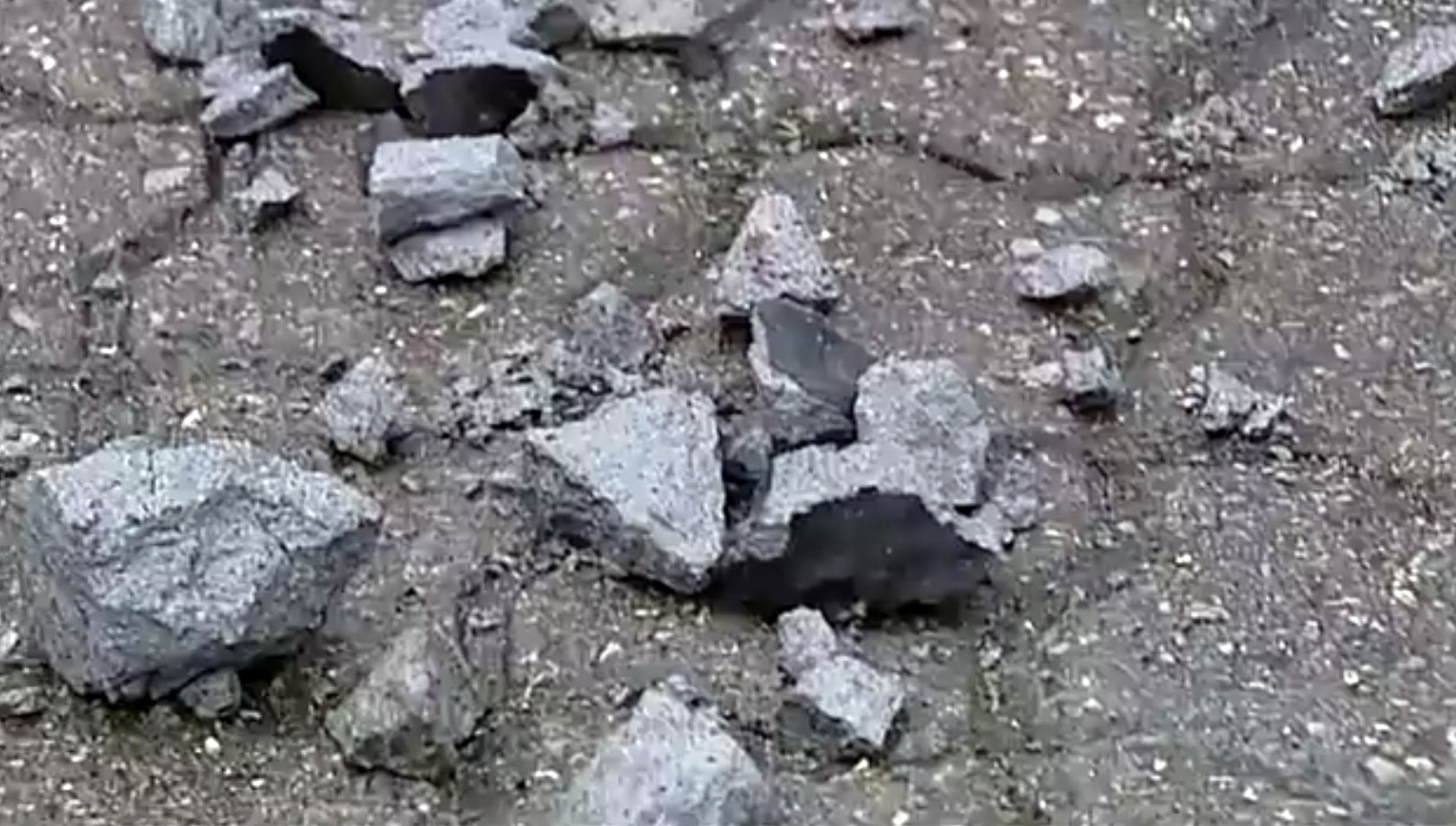

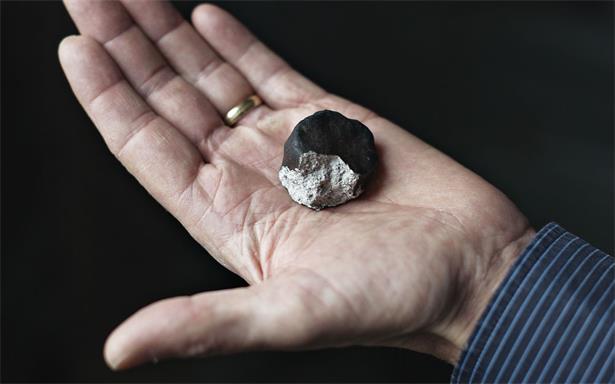
































Dear karmaka.
The purpose of this “reply” is to close the speculations about the mass of the “Herlev main mass” potentially being some 6,5 kg + 700-800 grams!
SUMMARY: THE TOTAL MASS IS 6,5 KG – ALL INCLUDED.
Argumentation:
1. In the official report on metbull (1), H. Haack reports the weight of the Herlev main mass meteorite (which shattered into hundreds of fragments) as 6,5 kg!
2. In 2 Karmaka reports (2,3) it is claimed that Dr. Daniel Wielandt (DW) on the 8. Feb reported the mass of the Herlev main mass meteorite as 6,5 kg. However no reference is provided! Most likely because this is simply a misunderstanding! [ karmaka: Yes, it was a ‘misunderstanding’ or rather a mistake while composing the texts you mentioned (2,3). They have been corrected accordingly. Thank you for your comment!]
3. In fact, many danish news media cites Ritzau (News agency) for the information, that DW estimated the mass as 0,5 kg (4, 5, 6) on the 8. Feb. In an interview to TV2. (Yes 0,5 kg!)
4. TV2 television were on location and recorded when DW (in black leather jacket) arrived at the impact site. A video is available (7). He talks about the shattered meteorite and info on mass are probaly conservative guesstimates by eyeballing (most likely no scale used, since television was on scene when DW arrived).
It should also be remembered that the fragments are spread over a rather big area, many fragments probably not visible from DW’s perspective.
5. First report of a total mass of 6,5 kg for the Herlev main mass, that I can find is an inofficial report from Lars Malmgren on the 15. February at 23.54 danish local time (8).
At this point in time (7 days after the discovery) all fragtments of the Herlev main mass are likely to be in the hands of the geological museum. Including the 700-800 grams of fragments collected by Eva Diemar on the 8. February.
Refs:
)1 : http://www.lpi.usra.edu/meteor/metbull.php?code=63682
)2 : http://karmaka.de/?p=7261
)3 : http://karmaka.de/?page_id=7682
)4 : http://www.tv2lorry.dk/artikel/nye-meteoritfragmenter-fundet-i-herlev
)5 : http://jyllands-posten.dk/indland/ECE8427454/nye-stykker-meteorit-er-fundet-paa-pplads-i-herlev/
)6 : http://www.b.dk/nationalt/nye-stykker-meteorit-er-fundet-paa-p-plads-i-herlev
)7 : http://nyheder.tv2.dk/2016-02-08-her-er-meteoritkrateret-i-herlev-der-har-vaeret-knald-paa
)8 : http://www.astro-forum.dk/forum_posts.asp?TID=14910&PN=8
BR Frank W. Rasmussen